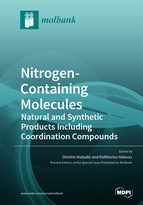Nitrogen-Containing Molecules: Natural and Synthetic Products Including Coordination Compounds
A special issue of Molbank (ISSN 1422-8599).
Deadline for manuscript submissions: closed (31 August 2021) | Viewed by 42638
Special Issue Editors
2. Institute of Biosciences and Applications, National Centre for Scientific Research “Demokritos”, 15310 Athens, Greece
Interests: heterocyclic and medicinal chemistry; organic synthesis; antimicrobial agents; structure–activity relationships of bioactive compounds; curcuminoids; tetramic acids; pyrazolines
Special Issues, Collections and Topics in MDPI journals
Interests: nano-sized systems; drug encapsulation and delivery; drug targeting; surface functionalization; material characterization; controlled release; natural products; metal complexes; radiopharmaceuticals
Special Issues, Collections and Topics in MDPI journals
Special Issue Information
Dear Colleagues,
Nitrogen constitutes one of the most crucial elements in synthetic compounds, both organic and coordination. After all, urea is considered to be the first synthetic organic compound (it was first prepared in 1828 by Friedrich Wöhler from a mixture of the inorganic compounds silver cyanate (AgOCN) and ammonium chloride (NH4Cl)).
From a medicinal chemistry viewpoint, nitrogen is a very common element in every major class of active pharmaceutical ingredients existing in heterocyclic and in acyclic molecules. Functional groups like amines, imines, nitriles, amides, and carbamates dominate the libraries of bioactive compounds, whereas the total number of unique drugs containing at least one nitrogen heterocycle among FDA-approved pharmaceuticals is 910 (84% among 1035 unique small-molecule drugs). The top-5 most frequent nitrogen heterocycles in this list are piperidine, pyridine, piperazine, β-lactam, and pyrrolidine.
Until today, the combined use of synthetic organic chemistry and coordination chemistry has generated a number of new and effective synthetic methods of high-rate product formation for important classes of coordination compounds of several nitrogen-containing ligands with numerous metal ions, giving rise to novel materials with exceptional physicochemical, biological, medicinal, catalytic, and optical properties.
For the Special Issue “Nitrogen-Containing Molecules: Natural and Synthetic Products Including Coordination Compounds”, we welcome the submission of research articles related to one or more of the following: design and synthesis; structural characterization by means of NMR; X-ray crystallography; or other preliminary but significant results including but not limited to biological evaluation, theoretical calculations/molecular mechanics/computational studies, material or physicochemical properties of nitrogen-containing molecules, and/or coordination compounds of nitrogen-containing molecules.
Dr. Dimitrios Matiadis
Dr. Eleftherios Halevas
Guest Editors
Manuscript Submission Information
Manuscripts should be submitted online at www.mdpi.com by registering and logging in to this website. Once you are registered, click here to go to the submission form. Manuscripts can be submitted until the deadline. All submissions that pass pre-check are peer-reviewed. Accepted papers will be published continuously in the journal (as soon as accepted) and will be listed together on the special issue website. Research articles, review articles as well as short communications are invited. For planned papers, a title and short abstract (about 100 words) can be sent to the Editorial Office for announcement on this website.
Submitted manuscripts should not have been published previously, nor be under consideration for publication elsewhere (except conference proceedings papers). All manuscripts are thoroughly refereed through a single-blind peer-review process. A guide for authors and other relevant information for submission of manuscripts is available on the Instructions for Authors page. Molbank is an international peer-reviewed open access quarterly journal published by MDPI.
Please visit the Instructions for Authors page before submitting a manuscript. The Article Processing Charge (APC) for publication in this open access journal is 500 CHF (Swiss Francs). Submitted papers should be well formatted and use good English. Authors may use MDPI's English editing service prior to publication or during author revisions.
Keywords
- nitrogen heterocycles
- coordination compounds
- amines
- pyridine
- Schiff bases
- metal complexes
- metal–organic coordination chemistry
- organic chemistry







